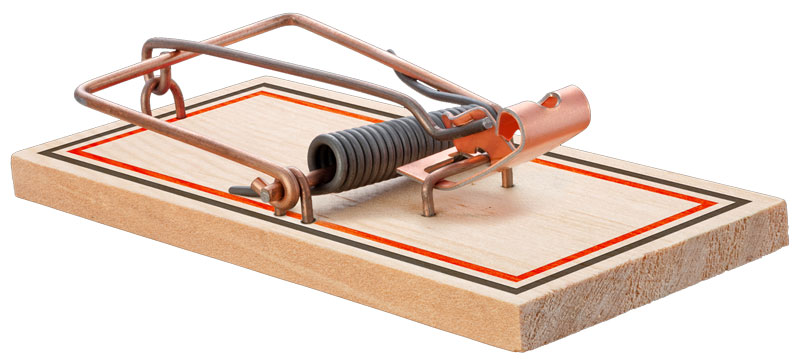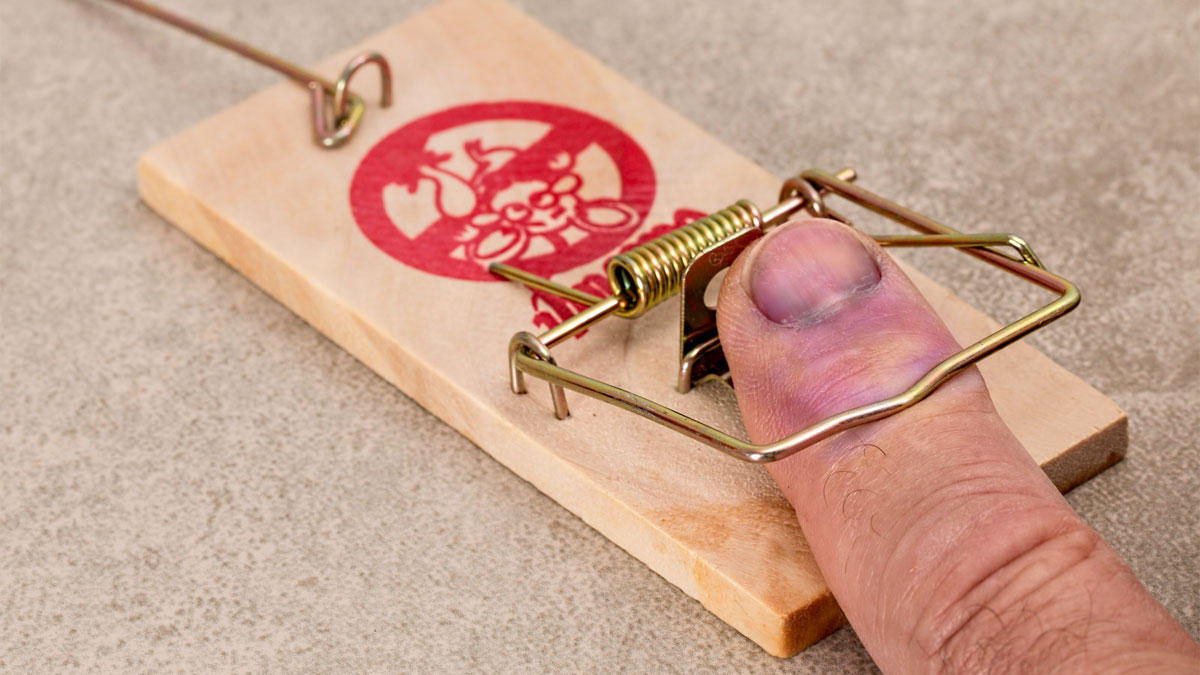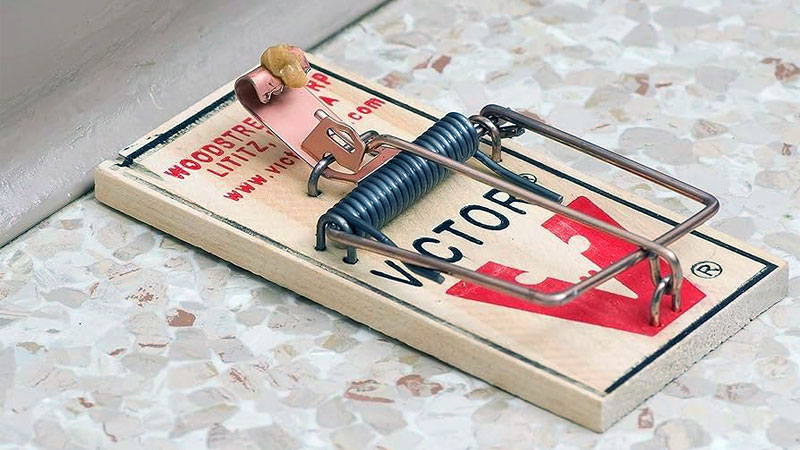Few things are as jolting as the loud snap of a mouse trap. While effective at catching mice, common snap traps can also catch fingers and hands if not set properly.
There’s an art to properly setting a mouse trap, from choosing the right bait to using the right technique when pulling back the spring-loaded bar. By following the steps below, and you can eliminate those pesky rodents while keeping your digits intact.
An electronic mouse trap will be your best friend.
How Do Mouse Traps Work?
To know how to set a mouse trap, you first should have a good understanding of how a mouse trap works. Mouse traps have been around for over a century and have changed little over the years: a testament to their effectiveness.
A proper mouse trap needs only a strategic location and good bait. People have used these devices for decades and have found them easy to operate.

Mouse traps have simple but effective mechanics. The spring loaded-bar sits on a small wooden or plastic platform. Bait is placed near the trap’s spring mechanism, which is triggered by the weight of the mouse as it steps onto the platform to eat the bait.
The spring-loaded bar releases with enough force to kill the unsuspecting mouse nearly instantly.
- The original wood based wire snap trap with large scented plastic trip pedal
- Clean and quick trapping
- Can be used around food, water, children, and pets
Why Is Safety an Issue When Setting a Mouse Trap?
Because the standard mouse trap is meant to kill the mouse, it must have sufficient force behind it. While the force delivered by a mouse trap may seem harmless at its small size, it can pose a danger for fingers during the setup process.
Not only are you in danger, but also dogs, cats, or children who may be present in the home can also be hurt. Mouse traps present a danger for the following reasons:
- They have reasonable strength in their spring-loaded bar system.
- They can be easily forgotten if placed improperly.
- Curious children and pets can find themselves hurt by the device.
- If the proper setup technique isn’t followed, the device can go off on an unintended target (fingers).
While some mouse trap variations have safety devices in place, the conventional snap trap does not. Understanding how the trap works and where to best place it is your best bet to avoid any accidents.
How to Set a Mouse Trap Without Getting Hurt
To minimize the chance of an accident, there are certain things you need to do when using a mouse trap. Mice are clever little creatures and survivalists above all. Setting up a mouse trap goes beyond just placing the bait and walking away.
Setting Up
How to set a mouse trap: the key issue above all is to be sure you are keeping your fingers clear of the spring loaded-bar once it is set. To set the device, follow the steps below:
- Put on some gloves. While they may offer some protection against accidentally snapping yourself, their main purpose is actually to keep your scent off the trap.
- If it’s a brand new trap, remove the staple that’s keep the bar temporarily in place.
- Slowly move the arm bar of the trap and let it hang over the back of the trap.
- Apply the bait (see below).
- Pull the kill bar back, holding it with your thumb securely
- Place the arm bar over the kill bar and secure it
Most mouse traps will have a small tab on the pedal near the front where the arm bar can be secured. Once the trap is secured, it needs to be handled with care. Using some type of grabber tool is great when moving a set trap to its final location.
Some traps are more sensitive than others, so you need to be careful. Those that are most sensitive are usually labelled as such.
- EASY GRABBING: Reacher grabber to pick up items with easy, picks up coins,...
- FOLDABLE DESIGN: Adopt folding type design, shorten length, facilitate outdoor...
- ROTATING Head: The claw grabber’s head can be rotated up to 90 degrees, which...
Proper Placement
Correct placement is key when setting up a mouse trap. You want to be sure that traps are set in places where mice can reach them but are not accessible to pets and children.
Think of places like under the sink or behind the fridge. These are mice hangout areas but certainly not places children can get to. It may even be in the back of your dresser drawer. A properly placed mouse trap is a highly effective mouse trap.
But it’s worth keeping in mind the negatives of a hard-to-reach mouse trap. If the trap does its job and you forgot where you put it, you now have a new problem on your hands… finding and getting rid of a dead mouse smell!
What Bait to Use
The bait used to lure mice is important. You want to find a bait that gives the trap enough time to be effective.
Most people think of small pieces of cheese or crackers when they think of mouse traps, but these are not always good options. Some mice may be large enough to scurry away with the bait fast enough to not get caught, so not underestimate them.
Foods high in protein are always a good choice. Think of peanut butter or hazelnut spread. The scent will be strong and it will keep the mouse in place. Mice also enjoy the same seeds that birds like, so it can be effective to place peanut butter on the trap with some seeds within it.
Disposing of Your Mouse Trap
Once the mouse has been trapped and killed, it is time to clear the trap. This may seem like a harmless part of the process but the truth is that it can present health concerns.
Once the mouse trap has done its job, it should leave a small, dead and decomposing animal on it. You should wear disposable gloves when handling the mouse trap and dispose of the entire device, preferably in a garbage container outside of your home. Again, a trusty grabber tool is a good way to dispose of the used mouse trap without getting too close to the victim.
While it’s technically possible to clear and reset a snap trap, at about $1 each, it’s rarely worth the effort. In some cases, the trap won’t function correctly the second time.
History of the Mouse Trap
Mouse traps were introduced in the late 1800s. Rodents ran rampant in Europe during much of the preceding centuries and the device was overdue.
William C. Hooker of Illinois was the man who patented the first mouse trap in America in 1894. Just a few years later, the devices were being used in Europe. The spring loaded-bar device has been so efficient over the years that few changes have been made to it since its inception.
Where to Buy Mouse Traps
Mouse traps are sold commercially worldwide. You can find many variations at Home Depot, Lowe’s, Ace Hardware, D&B, Tractor Supply, and others. Even grocery stores and gas stations sometimes sell basic snap traps. Obviously, online retailers like Amazon offer them.
- The original wood based wire snap trap with large scented plastic trip pedal
- Clean and quick trapping
- Can be used around food, water, children, and pets
- 100% Kill Rate - Beveled columns also help to keep the mouse in place over the...
- Humane, High-Voltage Shock - Once inside, the circuit triggers a high-voltage...
- Built-in Safety Features - A safety switch automatically deactivates the trap...
The cost of mouse traps is generally affordable, which allows for multiple purchases. Good old fashioned snap traps are typically sold in multi-packs.
Mouse traps can vary in their sophistication, and some of the modern versions are meant to just capture the mouse and not kill it. Catch and release mouse traps are popular these days, but for the purpose of this piece we are sticking to the conventional mouse trap.
Related: If You See a Mouse, How Many More Do You Have?
Tips
Now that you know how to properly set a mouse trap, it’s important that you understand that mice are crafty creatures. Simply setting the trap anywhere and walking away isn’t a good strategy.
To catch a crafty mouse, you will want to avoid making certain mistakes. Mice are not brilliant creatures but they are perceptive and will have a good idea of which areas to avoid.
Identify Mice Runs
Identify mice runs by following any droppings they left behind from the night before. Once you have a good idea what areas of the kitchen or home the mice frequent, you can begin setting the traps properly.
Setting the trap along a wall or in a corner will often be your best bet. Place the trap perpendicular to the wall so the bait pedal is closest to the wall.
Eliminate Human Scent
When setting a mouse trap it is important that you eliminate human scent by wearing gloves. Mice are not necessarily smart enough to know that a mouse trap is set to kill them, but they will stay away from it if it has a strong human scent as that is one of their repellents.
Gloves should help to mask some of the scents and will increase your chances of success.
Try Different Bait
If the old peanut butter trick just isn’t working, try something different as there are different types of mice with different preferences. High-calorie sweets and fats are perfect because they typically have a strong scent. Anything large enough to fit in the trap is good because it keeps the mouse in place.
If you want to use cheese, use a cheese with a strong odor. In general, mice like the same food we do, which is one reason they like to live in our homes!
- How to Identify Skunk Poop (With Pictures) - April 1, 2024
- You Really Don’t Need That Opossum Trap - January 4, 2024
- How to Set a Mouse Trap Without Getting Hurt - December 28, 2023





